Be the change that you want to see in the world. Mahatma Gandhi
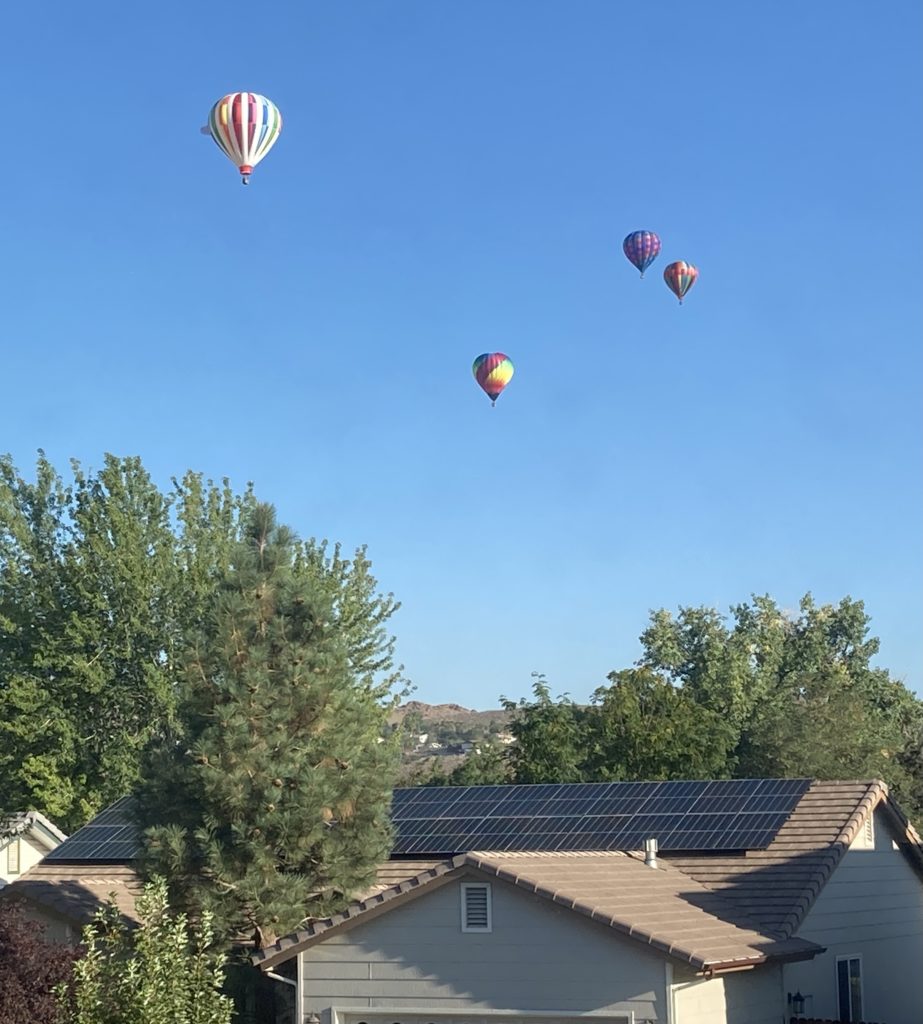
We also removed the tall pine tree that was shading the panels.
Our Online SolarEdge Panel. Click to see what we are producing with our rooftop solar array!
Our gratitude to Travis and the guys at Great Basin Solar (https://www.greatbasinsolar.com/) for the awesome job they did designing and installing our system, including the 8 new panels we added this year.
Our New Quest to Reduce Our Carbon Footprint
In the summer of 2021 we lived through two months of skies darkened and polluted by wildfire smoke, while we watched the effects of climate change rippling across the world. It was heartbreaking. We can no longer deny that this is happening, nor can we wait for someone else to fix it. Scott and I decided we must decrease our carbon footprint as much and as quickly as we can. We will share our experience here in hopes that we might inspire others to join us in the quest. When all of us do what we can, we create a tidal wave of change! According to the latest report by the Intergovernmental Panel on Climate Change, we have a limited time to reduce global greenhouse gas emissions before we reach a point of no return. They are asking us to cut our emissions 50% by 2030.
What we have learned during this journey is that we can drastically reduce our carbon footprint without sacrificing a comfortable, modern lifestyle. There are great technologies out there to help like solar panels, heat pump systems and electric vehicles, which allow us to cut our emissions significantly. It is actually not that difficult to replace old systems with these technologies and it makes such a difference. It’s also easy to install these more efficient systems in newer homes. In Nevada we are lucky to have this amazing sun and a net metering power company that allows us to bank and use our excess solar energy. Did you know that the biggest part of our carbon footprint comes from the energy we use in our homes and vehicles?
Here is the calculation of our Carbon Footprint and how it has changed since we began this journey:
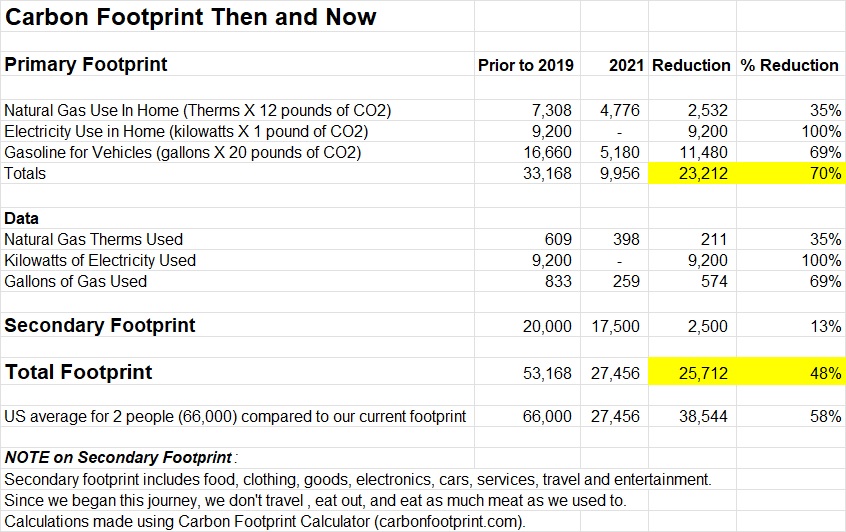
We were thrilled to see that we have already cut our total footprint by 48%, and we cut our primary footprint by 70%! We were surprised we had already come so far in our quest. Now let’s see how much lower we can go!
Reflections on our Third Year of Going Solar, Greening our Home & Driving the Cars of the Future
This is kind of like trying to eat one potato chip, once you get going you can’t stop! It seems that we are always finding new ways to reduce our carbon footprint. I can’t express how wonderful it feels to see a long-time dream of ours coming true–living in a green home and driving green vehicles. It has helped us both to feel less helpless about climate change and more hopeful about what is possible in our collective future.
I always thought it would be expensive and require a lot of sacrifice to realize this dream. We haven’t had to sacrifice any of our usual modern comforts to make this change. We live in a standard home built in 1999 with extra insulation and efficient windows. It turns out for the cost of a kitchen remodel, you can go solar and green a home like ours. Plus it increases the value of your home so much that it pays for itself almost immediately. This year a study by the National Bureau of Economic Research showed that homes with solar panels sold at a 4% premium. Studies are also showing that homes with solar and other energy-efficient improvements are selling faster and at even higher premiums. Buyers know that they are buying savings when they purchase these upgrades with a home. You get even more for a home that is equipped with a fast charger for electric vehicles, which runs off the panels. This adds the additional savings on gas plus the convenience of in-home charging, and it is so much fun to drive an EV!
Summary of 2021
In 2021, we used our stimulus money to add 8 more panels to our roof and replace our broken old gas water heater with a new hybrid heat pump model (see the April 25, 2021 post). We also decided to cut down the big pine tree and smaller maple that were shading our panels. They were too close to the house and sitting on top of water and electrical lines. Not a good planting decision on our part… It’s looking like we might get a 10%+ bump in our production as a result! We tried to add a heat pump HVAC system, but unfortunately the supply chain problems kept us from securing a unit this year. We will keep trying in 2022.
Here’s the summary for this year with cumulative data:
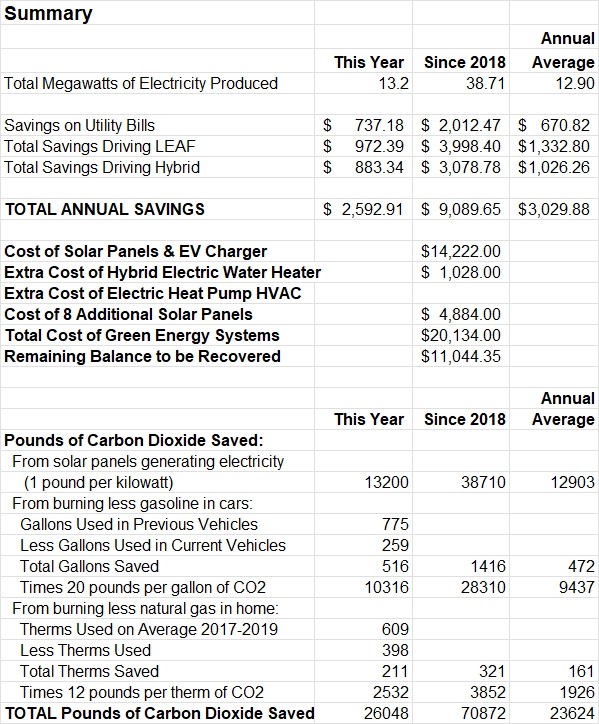
We produced about 13 megawatts of power this year, about 300 kilowatts more than last year. We are hoping that the 8 new panels will get us closer to 17 megawatts next year. We saved $737 on our utility bills, which was improved by installing the new electric water heater. It will use about 1 megawatt of electricity per year and it dropped our gas use another 20%! The biggest savings comes from driving one electric car and one hybrid.
We are still loving our cars and saving money driving them instead of our old gas-powered vehicles. This year they both required some maintenance–a 15,000 mile service for the Highlander and new tires and a door handle repair on the LEAF. This reduced our savings from previous years, but we saved more on gas due to the higher price per gallon. We saved a total of $1855 for the year!
We added the cost of the new hot water heater over and above what it would have cost us to replace it with a gas model. We also added the 8 additional solar panels to our costs, less the 26% federal tax rebate. We now have a total of about $20,000 invested in greening our home. We have recovered about $9,000 in just the first three years!
We didn’t include the cost of our vehicles, since they cost about the same as we would have spent on gas powered cars. I actually just discovered that a 2016 Nissan Juke, which is the ICE most comparable to the 2016 LEAF was actually selling at $6,500 more! We got such a good deal on the Toyota Highlander that it was only about $1,000 more than the same ICE model. So, even though I haven’t counted the cost of the cars, we actually saved about $5,000 on the pair because the LEAF was so cheap.
What we are most excited about is saving 26,000 pounds of carbon from entering our atmosphere this year! Over the last three years we have saved nearly 71,000 pounds of carbon! The savings come from a combination of generating solar power for our own home and the local grid, and reducing our use of natural gas and gasoline. Note: Carbon footprint and carbon savings are different calculations, so the numbers shown in the two tables differ.
2022 Plans
In 2022 we will add the heat pump HVAC system to further reduce our use of natural gas. It will by a hybrid system, which uses our high efficiency natural gas furnace to back up the heat pump when temperatures fall below freezing. We are also planning to go all EV! It is our hope to trade the Highlander for an all electric SUV later in the year. The ranges and charging stations are finally at a point that we think it’s time to take the plunge. That will be another big adventure for us. We’ve also decided it is time to let go of our beloved little teardrop trailer, Pearl. We have enjoyed her for 7 years but aren’t using her very much anymore. We purchased the Highlander primarily as a tow vehicle for Pearl. Without the need to tow a trailer, we can get a regular size SUV which will use less electricity to power.
THE DATA FOR MY FELLOW NERDS:
Electricity Production and Accumulated Credits
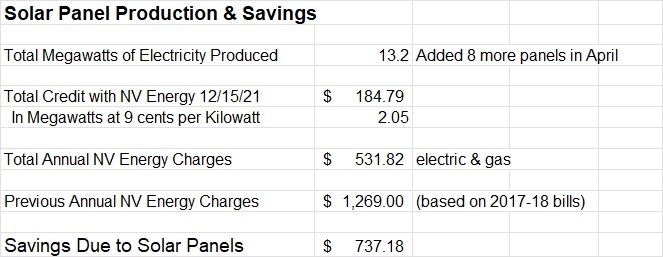
We produced 13.2 megawatts, about 300 kilowatts more than last year. We installed the 8 new panels in September and saw a jump in our production that month. But then there was a stormy fall and December, so it leveled out for the rest of the year. It will be interesting to see what happens next year, especially now that we have taken out those trees. That seems to have boosted our output by at least 10%.
Our banked power with NV Energy went from 2.5 to 2.0 megawatts, so that means we used about 800 kilowatts more power this year than last. This is about right for powering the new electric water heater and the extra miles we drove the LEAF in 2021.
We saved a $736.18 on our utility bills by reducing our natural gas usage in addition to generating our electricity!
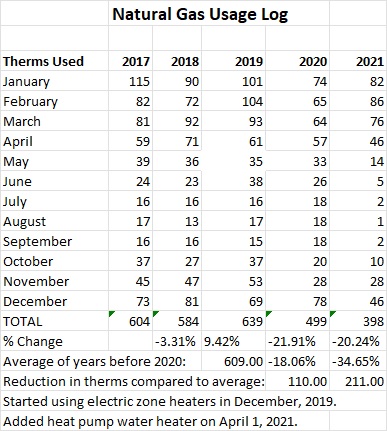
Now we are using about 35% less gas than we did before.
We also saved 2500 pounds of carbon!
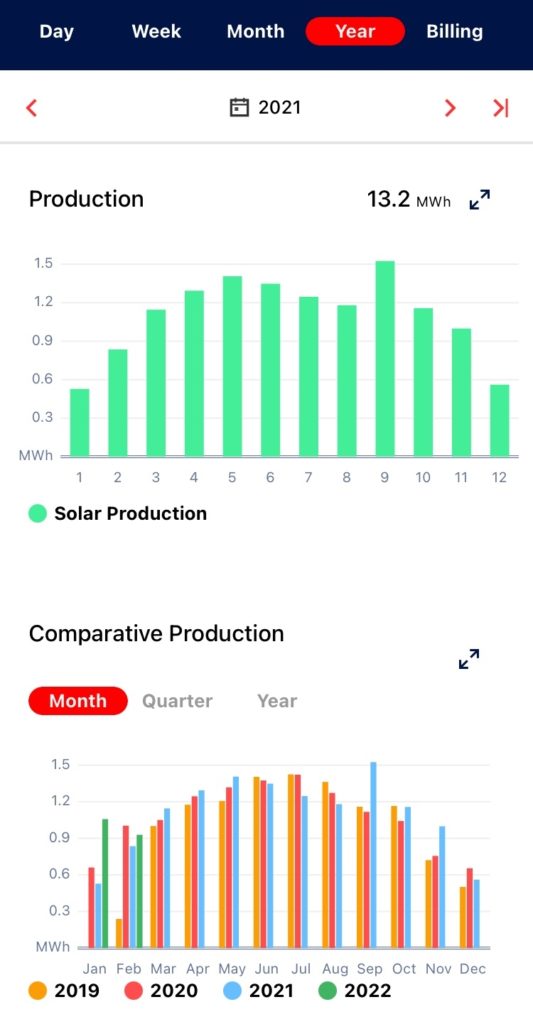
These are the graphs from our SolarEdge inverter showing the production of electricity off our roof. You can see the jump in September when we added the new panels. Then how it leveled off with a stormy fall, but is now up in 2022. (February data was only for about 2/3 of a month.)
You can see that our lowest production months are November-January, which is when we are using the electric zone heaters and running Christmas lights. It’s during these months that we tap into our banked power with NV Energy. In the higher production months, we send more power into the grid, which is used by other households and increases our banked power.
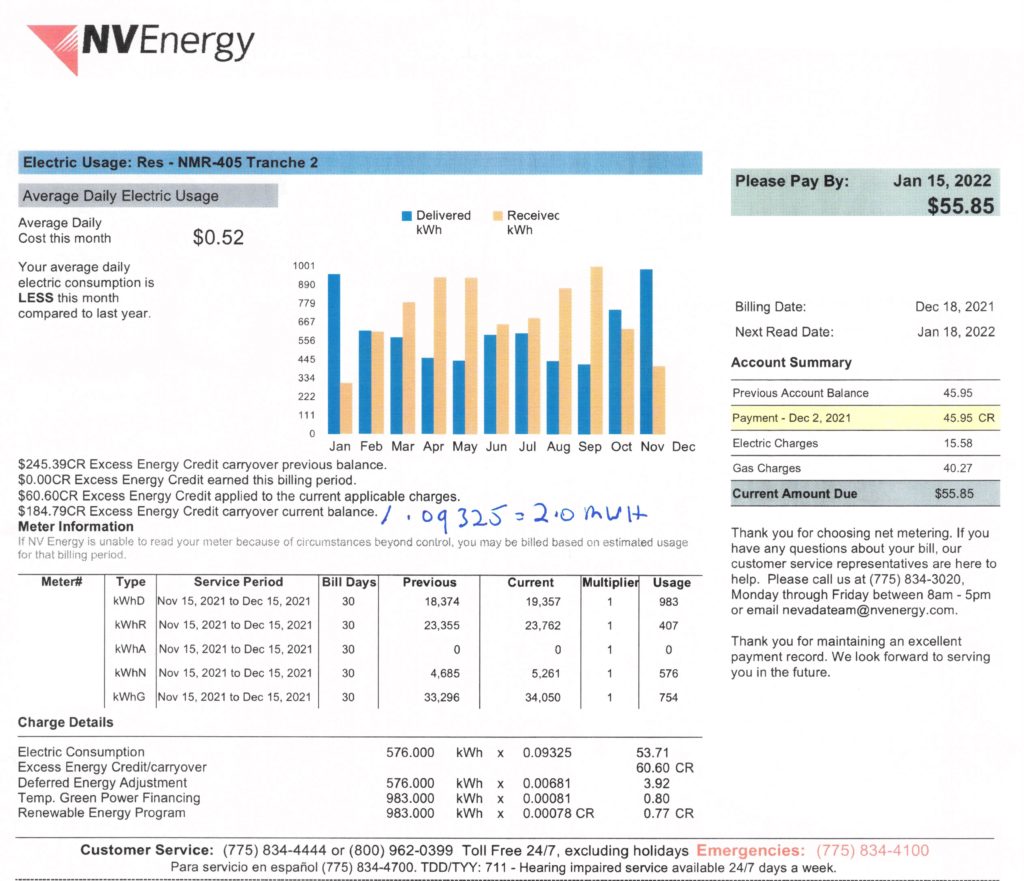
Hand calculation is of our stored bank of 2 megawatts
(Bank of $184.79 divided by price per kilowatt of .09325)
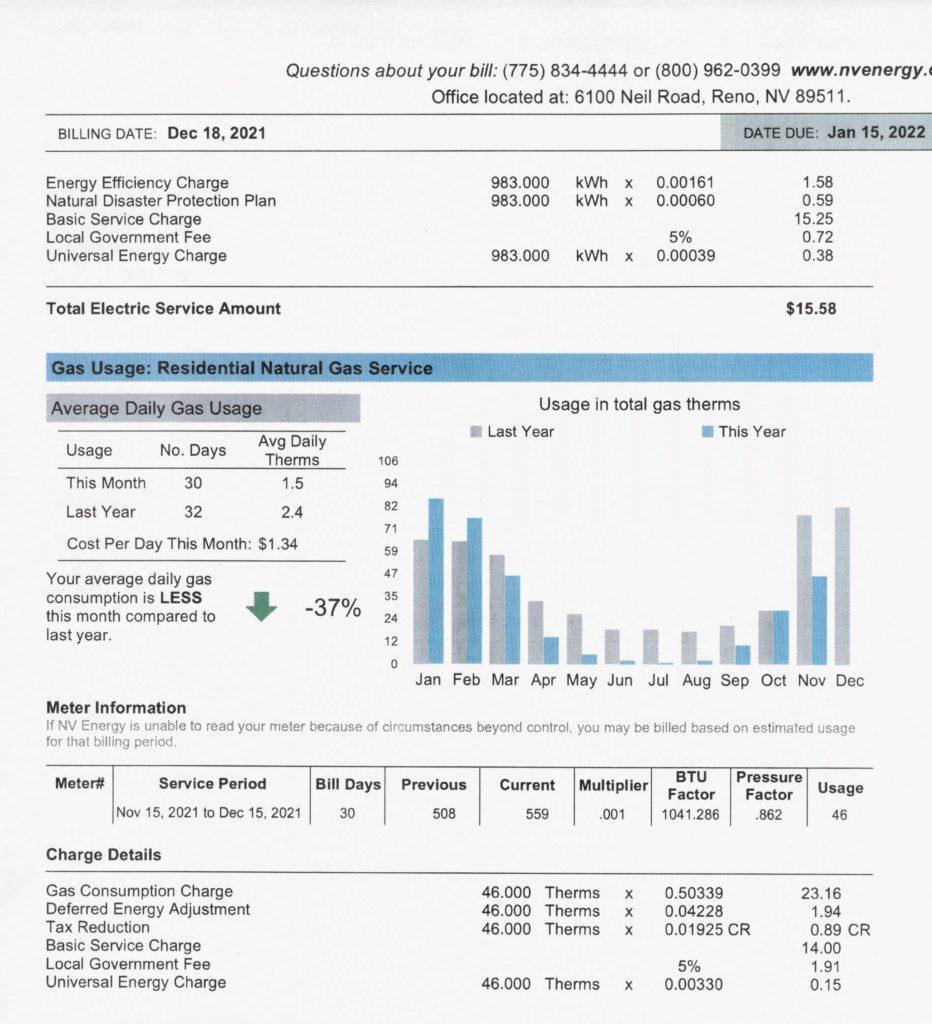
2016 Nissan LEAF
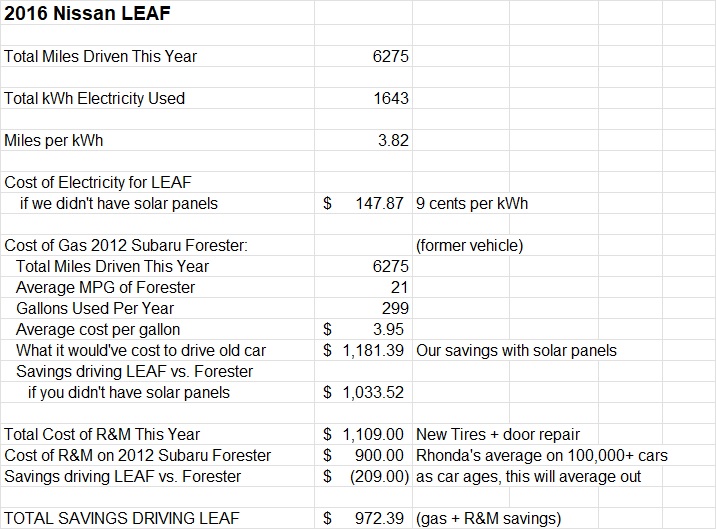
We drove the LEAF more this year since we are now my mom’s sole source of transportation. She stopped driving in April 2021. So, we save even more carbon and money having one less car in the family, plus we don’t have to pay for gas to use the LEAF! The average cost of gas went up over $1/gallon, so we saved even more using the EV. Our gas savings was nearly $1200. Plus we saved nearly 6000 pounds of carbon dioxide from entering our atmosphere (299 gallons X 20 lbs/gallon of gas). It took 1.6 megawatts to power BeeBee, which would have cost $148 for the year if we didn’t have solar panels. This represents a savings of over $1034 over a gas powered vehicle.
BeeBee required a little more maintenance this year–new tires and a front door handle repair. However, new tires are about the most expensive thing you have to buy for an EV, so I expect this will average out over time to significant savings in maintenance on the LEAF.
We are noticing about a 20% decline in the LEAF’s range at the 5-year mark. A full charge gets you closer to 90 miles now vs. the 110 she used to get. However, that is still well within our range limit of 50 miles, which easily gets us around town more than once. We expect she will meet our needs for another 5 years.
2019 Toyota Highlander Hybrid
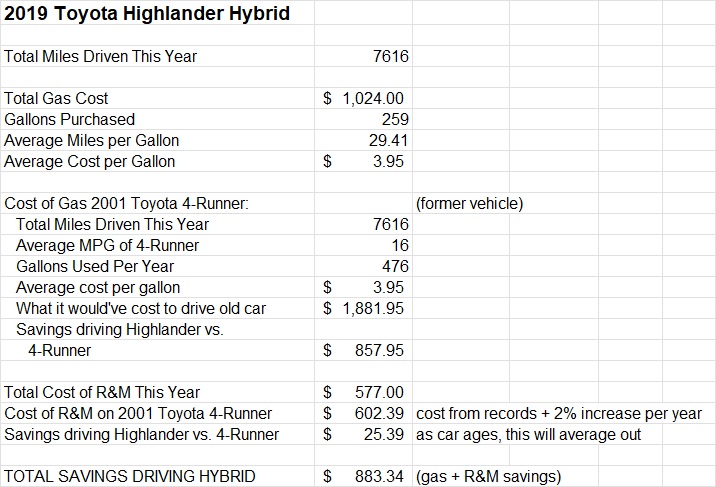
We did some road trips in the Highlander this year, increasing our mileage by about 3000 miles. This used about 100 gallons more gas than last year, but about 200 gallons less than the 4-Runner would have used. This saved $858 and 4,000 pound of carbon emissions.
The Highlander came off its two-year maintenance contract in 2021 and had its 15,000 mile service, which was $577. This is an expensive service, so closer to the old 4-Runners average R&M cost of $602. If we kept the car, this would average out over time. Most hybrids cost about 2/3 as much to maintain as an ICE.
We love our Highlander and it is truly a pleasure to drive, but with our new quest to reduce our carbon footprint, we feel compelled to go all EV in 2022. We bought this car primarily to tow Pearl (our teardrop) and go on road trips. We are finding we rarely use Pearl now–only once a year for a group camping trip. It makes more sense to us to sell Pearl and rent an RV, which allows us to drive a smaller SUV. Our plan is to trade the Highlander for a new EV that qualifies for the federal tax credit. So stay tuned for another exciting year of greening our life and going all EV!